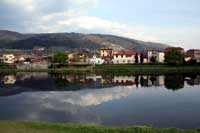The Territory Prato, information for tourists!
 Prato is a town that boasts about 185,000 inhabitants and is the capital of the homonymous province. Regarding population growth, we must clarify that Prato, in recent years has seen a very significant demographic boom leading her to be talking about population, the second city after Florence in Tuscany.
Prato is a town that boasts about 185,000 inhabitants and is the capital of the homonymous province. Regarding population growth, we must clarify that Prato, in recent years has seen a very significant demographic boom leading her to be talking about population, the second city after Florence in Tuscany.
Spend summer in Prato means for the tourists take a dip in the past, with an eye toward the projected future!
To visit on holiday in Prato
Palazzo Datini: fourteenth-century frescoes stay outside, today is a museum that holds the first books, bills and credit cards. It is located in Via Ser Lapo Mazzei, 41.
Phone: 0574 213 91
More informationPiazza del Comune: characterized by the statue of the well-known merchant Francesco Prato Datini, designed by Antonio Garella, is located next to Praetorian Palace, the only example of Swabian architecture in northern Italy.
More informationMuseo dell'Opera del Duomo: inside panels original Donatello to the pulpit of the Sacred Cingolo, the Reliquary for Cingolo of Maso di Bartolomeo and frescoes by Filippo Lippi and Filippino. Located in Piazza del Duomo.
Phone: 0574 293 39
Famous in Italy and worldwide for its textile industries, which for centuries constitute a major resource, Prato is also a non-artistic indifferent. In particular, visitors will notice an approach to contemporary art, which is the highest expression in public areas of the Museo Pecci of Prato.
Tourists will be impressed by the fact that in the outskirts of Prato, several are the areas in which were found important archaeological excavations have brought to light the strong presence of the Etruscans, visible through the necropolis and exhibits scattered in small villages in the province, as Comeana and Artimo.
An industrial zone always in step with the times that switches to the great wealth landscape is what gives the territory of Prato. If on the one hand, the city seems to be a car competition, which focused on industry, machinery and intent to promote an art that increasingly looks to the future, the other Prato is lost in its immense valleys, in huge landscapes, including vineyards, fields, the hills and magnificent stretches of the campaign, in the areas of the Val di Bisenzio and Montalbano Pratese.
As for the territory, Prato is a city that is part of Tuscany north-east and has an area of about 100 square km. Located at the foot of the mountain of Retaia, and the highest peak of the town of Prato is that of Mount Cantagrilli. The river crossing is Prato the Bisenzio, a tributary dell'Arno.
The climate
The climate of the city is characterized by very cold winters but rather dry, as opposed to really hot summers and sultry, while as far as we can say that rainfall is concentrated in particular in autumn and sporadically in the spring.
Fractions
- North constituency: Cerreto, Chiesanuova, Coiano, Figline of Prato, Galcetello, Galceti, The Abaton, I Cilian, Le Fornaci, Le plates, bags, San Martin, Saint Lucia, Villa Fiorita
- South constituency: Cafaggio, Casale, Castelnuovo, Campostino, Fontanelle, Grignano, Iron, iolo, Le Badie, Le Caserane, Le Colombaio, Le Fonti, Donald Duck, Ponte to Vanne, populace, Purgatory, San Giorgio a Colonica, San Giusto, Santa Maria in Cologne, St. Andrew, Wood, Tobbiana
- East constituency: Canneto, Paper, Cavaglia, Filettole, Gonfienti, The Shipyard, I Lecci, The Stage, La Castellina, the grinding, La Pieta, The Oaks, Mezzana, Pizzidimonte, Ponzano, Holy Family, Santa Cristina a Pimonte, Santa Gonda
- West constituency: Borgonuovo, Capezzana, Galciana, The Chalice, The Ford, La Dogaia, Le Pantanelli, Maliseti, Mazzone, Narnali, San Paolo, Sant'Ippolito, Vergaio, Viaccia
- Constituency Center: The Pine, The Rescue, Reggiana
Name Population: Prato
Patron saint: Santo Stefano
Public holiday: Dec. 26